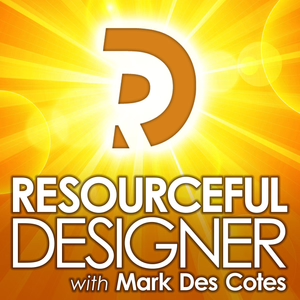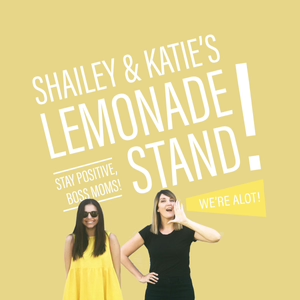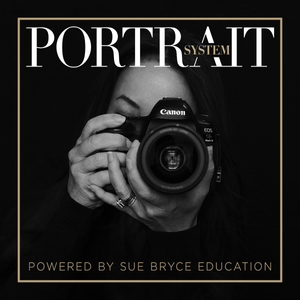
Why AI Generated Art Won't Replace Graphic Designers - RD308
12/12/22 • 26 min
1 Listener
Before I start, let me preface this by saying I am not an expert in AI-Generated Art. These platforms are still in their infancy, and nobody knows what the future holds for them or their effect on the graphic design industry, but I doubt they’ll ever replace graphic designers.
I’ve experimented with various platforms, read articles, and watched videos. I’ve seen both sites of the debate argued. Some people don’t see AI-Art as a threat to our industry, while others are all doom and gloom, saying designers should start applying to work at McDonald’s as flipping burgers will soon become more lucrative than designing things.
I don’t see AI-Generated art as a threat to the graphic design industry. And I’ll get to why in a bit. However, I’m not so sure about artists and illustrators. If that’s your profession, I suggest you pay close attention to how AI-generated art matures, as it will affect those creative people much more than it will designers.
As I said, I’m no expert here. And these AI Art Generators are evolving fast. So what I say today may change soon. Who knows?
I also haven’t tried all the various platforms nor used the ones I have tried to their fullest potential. So some of what I say today may be wrong. If that’s the case, if you know something I don’t, please reach out to me at [email protected]. I would love to be educated more on the subject.
First, a story.Before I begin my discussion on AI-Generated Artwork, I want to tell you a story that will help put my beliefs into perspective.
I entered the three-year Graphic Design program at my local college in 1989. The first two years were spent learning and applying design principles to our projects. We learnt things like design history, colour theory, using grids, layout hierarchy, typography and more. And we were taught the different tools of the trade, most of which are no longer in use and are considered archaic by today’s standards.
It wasn’t until our third year, once we were familiar and comfortable with what being a graphic designer was, that we were granted access to the computer lab. Computers were still new to the industry back then, and very few design agencies used them. When I started working at the print shop after graduation, the first two years of my employment were spent designing everything by hand before I convinced the owner to invest in Macintosh computers.
I don’t remember what year it was, but during school, a few of my classmates and I made a trip to Toronto for a graphic design trade show. It was the largest show of its kind in Canada and the third largest in North America. All the big names were there, including Adobe, Quark, and Microsoft, to name a few.
I remember overhearing a conversation between two design agency owners at a demonstration put on by Adobe. They were talking about the introduction of computers to the design industry. Both were concerned that computers would harm the design industry by minimizing what they considered a particular skill set, that of a graphic designer. To them, computers took the “Art” out of being a “Graphic Artist.”
With today’s mindset, It’s kind of crazy to think that back then, design agency owners thought computers would harm our industry. You can easily argue that computers have made the industry better.
Having lived through that period, I can tell you that even though computers didn’t harm our industry, they did change it. Drastically, in fact. QuarkXpress, Photoshop and Illustrator replaced the standard tools of the trade, such as wax machines, no-repro blu pencils and Letraset rub-on type. And I know a few designers who left the profession because they couldn’t grasp the use of computers.
So computers were introduced, the industry evolved, and the graphic design industry persevered.
Microsoft PublisherFast forward a few years, and personal computers are becoming more popular, with Windows-based machines outselling Apple. And Microsoft released a program called Microsoft Publisher that introduced an affordable means for anyone with a computer to “design” their material.
Quark and Adobe software costs thousands of dollars which weren’t feasible for most people. But Microsoft made Publisher affordable. And what do you think happened? The graphic design industry started to panic. With “design” software now available to the masses, designers would lose their jobs.
But you know what? Microsoft Publisher was introduced, and some people changed their thinking about design, yet the graphic design industry persevered.
WordPress.Around that same time, an innovation emerged called the World Wide Web. Businesses started embracing the idea of hav...
Before I start, let me preface this by saying I am not an expert in AI-Generated Art. These platforms are still in their infancy, and nobody knows what the future holds for them or their effect on the graphic design industry, but I doubt they’ll ever replace graphic designers.
I’ve experimented with various platforms, read articles, and watched videos. I’ve seen both sites of the debate argued. Some people don’t see AI-Art as a threat to our industry, while others are all doom and gloom, saying designers should start applying to work at McDonald’s as flipping burgers will soon become more lucrative than designing things.
I don’t see AI-Generated art as a threat to the graphic design industry. And I’ll get to why in a bit. However, I’m not so sure about artists and illustrators. If that’s your profession, I suggest you pay close attention to how AI-generated art matures, as it will affect those creative people much more than it will designers.
As I said, I’m no expert here. And these AI Art Generators are evolving fast. So what I say today may change soon. Who knows?
I also haven’t tried all the various platforms nor used the ones I have tried to their fullest potential. So some of what I say today may be wrong. If that’s the case, if you know something I don’t, please reach out to me at [email protected]. I would love to be educated more on the subject.
First, a story.Before I begin my discussion on AI-Generated Artwork, I want to tell you a story that will help put my beliefs into perspective.
I entered the three-year Graphic Design program at my local college in 1989. The first two years were spent learning and applying design principles to our projects. We learnt things like design history, colour theory, using grids, layout hierarchy, typography and more. And we were taught the different tools of the trade, most of which are no longer in use and are considered archaic by today’s standards.
It wasn’t until our third year, once we were familiar and comfortable with what being a graphic designer was, that we were granted access to the computer lab. Computers were still new to the industry back then, and very few design agencies used them. When I started working at the print shop after graduation, the first two years of my employment were spent designing everything by hand before I convinced the owner to invest in Macintosh computers.
I don’t remember what year it was, but during school, a few of my classmates and I made a trip to Toronto for a graphic design trade show. It was the largest show of its kind in Canada and the third largest in North America. All the big names were there, including Adobe, Quark, and Microsoft, to name a few.
I remember overhearing a conversation between two design agency owners at a demonstration put on by Adobe. They were talking about the introduction of computers to the design industry. Both were concerned that computers would harm the design industry by minimizing what they considered a particular skill set, that of a graphic designer. To them, computers took the “Art” out of being a “Graphic Artist.”
With today’s mindset, It’s kind of crazy to think that back then, design agency owners thought computers would harm our industry. You can easily argue that computers have made the industry better.
Having lived through that period, I can tell you that even though computers didn’t harm our industry, they did change it. Drastically, in fact. QuarkXpress, Photoshop and Illustrator replaced the standard tools of the trade, such as wax machines, no-repro blu pencils and Letraset rub-on type. And I know a few designers who left the profession because they couldn’t grasp the use of computers.
So computers were introduced, the industry evolved, and the graphic design industry persevered.
Microsoft PublisherFast forward a few years, and personal computers are becoming more popular, with Windows-based machines outselling Apple. And Microsoft released a program called Microsoft Publisher that introduced an affordable means for anyone with a computer to “design” their material.
Quark and Adobe software costs thousands of dollars which weren’t feasible for most people. But Microsoft made Publisher affordable. And what do you think happened? The graphic design industry started to panic. With “design” software now available to the masses, designers would lose their jobs.
But you know what? Microsoft Publisher was introduced, and some people changed their thinking about design, yet the graphic design industry persevered.
WordPress.Around that same time, an innovation emerged called the World Wide Web. Businesses started embracing the idea of hav...
Previous Episode

How To Notify Clients Of A Price Increase - RD307
Scan the news these days, and you’d be hard-pressed not to come across a story about price increases. The price of gas has gone up. Rents are increasing, and groceries are at an all-time high. It’s depressing, I know. But that’s the world we live in. And your business should be no different. At some point, you’ll have to raise your rates if you want to remain solvent.
The one benefit of inflation is that people are getting used to price increases. So it won’t be as much of a shock when you announce you’re raising your rates. Be that as it may, you still want to do it the best way possible to soften the blow for your clients.
So what’s the best way to announce a price increase to your clients? Let me share some methods with you, along with some points that will make the task easier for you and make your clients more receptive to the news.
Signs you should increase your prices.Before I get to how to increase prices, here are four signs indicating it’s time for you to increase your rates.
1) Your operating costs are increasing.As the cost of subscriptions, software and other expenses go up. You need to raise your rates to offset the economy’s effect on your business.
2) You’re consistently busy.Suppose you have an abundance of projects that never seems to end. Or you find yourself turning down work because you don’t have time for it. Raising your rates can help you offset things and enable you to engage the help of subcontractors to ease the burden.
3) You’re prices are too low.Some clients won’t take you seriously if your prices are too low. If you want to attract a higher level of clientele, you need to raise your rates.
4) You’ve increased your value.Over time, you’ll gain experience and knowledge. As the value you offer increases, so should your prices.
So now that you’ve deiced to raise your rates. Here’s how to inform your clients of the price increase.
Keep it short.Announcing a price increase is a serious matter, and you want to ensure your clients take notice.
Keep it short and to the point, if you tell your clients via email. There’s no reason to include any fluff or to go into the philosophy behind the price increase.
If possible, announce the increase alongside more pleasant news, such as new or improved services you’re offering. It will help soften the blow.
And make sure you give the clients a way to contact you should they want to discuss your new rates.
Tell only affected clients.Nobody likes to hear about price increases, even if they don’t affect you directly.
You may not be in the market for a new car, but hearing about rising automobile prices still leaves a bad taste in your mouth and may even affect your perception of the various auto manufacturers.
Don’t give your clients a reason to think negatively about you.
If you’re increasing the price of a business startup package you offer, there’s no reason to notify already established businesses because it doesn’t affect them.
Suppose the price of your website hosting and maintenance is going up. Notify the clients already paying for your plan. There’s no reason for you to tell clients whose websites you are not maintaining since it doesn’t affect them.
If you’re raising your hourly rate, only notify those clients you charge by the hour.
And there’s no reason to notify clients of a price increase if you’re not currently working on a project for them. They’ll find out the next time you give them a quote.
Only notify affected clients of these price increases. And if this means advising different clients about price increases for various services, so be it. Send out one letter to your web maintenance clients. Another note to your retainer clients. Another to your hourly rate clients, and so forth. Ensure your clients are notified only about the price increases affecting them.
Don’t give your clients a reason to think negatively about you if your price increase doesn’t affect them.
Give clients enough of a warning.The more time you give a client to accept and adjust to new prices, the better.
Clients will resent a sudden price increase far more than a price increase that will occur in the future. The more time they’re given to think about it, the easier it will be for them to accept the increase.
Don’t forget some clients may require time to adjust their budgets. More prominent companies may need approval from higher up the corporate ladder.
The idea is to give clients time to come to terms with your higher rates.
And if you’re worried about losing clients due to a price increase, remember that it’s much easier for them to pay your higher rates than finding someon...
Next Episode

A Look Back - A Look Ahead - 2022 Edition - RD309
A look back at 2022 and a look ahead to 2023.
Thank you for your continued interest in Resourceful Designer. You have no idea how much I appreciate you. Many great resources are available for learning and growing as a designer, and I’m humbled that you chose to spend a bit of your valuable time with me.
I am continuing my annual tradition. This last podcast episode of 2022 is my Look Back, Look Ahead edition. It’s where I reflect and share my year as a design business owner. Then I’ll look ahead at what I want to accomplish in 2023.
A Look Back at my 2022 goals.At the end of 2021, I set these goals for myself.
FAIL: Talk at more conferences. Even though we were on the downslope of the pandemic, I chose not to travel in 2022. Therefore I wasn’t able to talk at any conferences. I also made the decision not to speak at any virtual conferences. I’ve presented at virtual conferences and found the return wasn’t worth the time commitment to prepare and give my talk.
EVEN: Grow the Resourceful Designer podcast audience. Since the pandemic hit in 2020, my podcast listenership has dropped, but the total number of downloads has increased. I attribute this to older listeners giving up on the podcast while new listeners discover it and download multiple episodes.
ACCOMPLISHED: Grow the Resourceful Designer Community. The Community is my pride and joy. One day, when I’m no longer doing the podcast, I’ll look back at everything I did with Resourceful Designer, and I’m sure the Community will be my proudest accomplishment. The friendships formed and all the freely given help is more than I could have ever hoped.
If you’re looking for camaraderie with fellow designers and are not a Community member, I highly suggest you check it out.
ACCOMPLISHED: Do more consulting work. Several clients paid for my consulting service, both in and outside the podcast space. I added podcast brand audit as a service under Podcast Branding which brought in several consulting clients.
ACCOMPLISHED: Grow Podcast Branding. What started as an offshoot of my main design business has become my main business focus. Podcast Branding is earning me more money than my main business ever has, with much less effort.
Some of my numbers from 2022 Resourceful Designer- I released 30 podcast episodes. The lowest in a calendar year since I launched the podcast. As my Podcast Branding business increases, it’s become harder to make the time to produce the podcast.
- It reached over 710k total episode downloads in 2022. That’s an 80k increase over last year.
- Resourceful Designer released on Gaana, Boommplay, Deezer, JioSaavn and Resso.
- Resourceful Designer has listeners in 120 countries around the world.
NOTE: I didn’t actively promote my design business in 2022. Instead, I concentrated on growing my other business, Podcast Branding. I continued working with existing clients but made no effort to attract new ones.
- Worked on 43 design projects for 22 different clients (one fewer client than in 2021)
- Gained one new client in 2022.
- I lost one client due to closure.
- I sent out 27 invoices in 2022 (down from 41 in 2021)
- Revenue increased over 2021.
My Podcast Branding business was my moneymaker this year.
- Worked on 66 different projects for 47 different clients (more projects but fewer clients than in 2021)
- Revenue increased by 27% compared to 2021. Primarily due to websites.
- Launched 12 new websites for clients. (up from 9 in 2021)
- I appeared as a guest on three podcasts to discuss podcast artwork and websites, increasing my exposure.
- Podcasters hired me for projects outside the podcast space.
My previous goals will continue to carry over in the new year. Continue to grow the Resourceful Designer Community. Concentrate more on Podcast Branding and so forth.
New Goal for 2023.- Create new partnerships to grow what I offer at Podcast Branding.
- Expand the Resourceful Designer Community to include even more offerings than now.
- Do more consulting work.
- Explore video as a content platform for Resourceful Designer and Podcast Branding.
- Increase the number of website clients on my web maintenance plan.
Did you accomplish your goals for 2022, and What are your goals for the new year?
- Are you a s...
If you like this episode you’ll love

Resourceful Designer: Strategies for running a graphic design business

Joomla Beat Podcast | Web design, development, online marketing, social media & website management

Shailey & Katie's Lemonade Stand: Design Moms Finding the Happy Balance as Work-from-home Entrepreneurs

The Portrait System Podcast

Group Chat
Episode Comments
Generate a badge
Get a badge for your website that links back to this episode
<a href="https://goodpods.com/podcasts/resourceful-designer-strategies-for-running-a-graphic-design-business-1053/why-ai-generated-art-wont-replace-graphic-designers-rd308-26416377"> <img src="https://storage.googleapis.com/goodpods-images-bucket/badges/generic-badge-1.svg" alt="listen to why ai generated art won't replace graphic designers - rd308 on goodpods" style="width: 225px" /> </a>
Copy